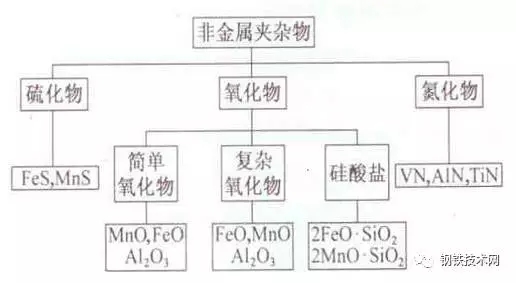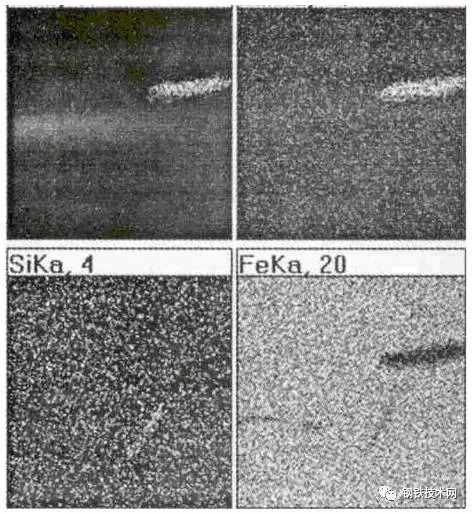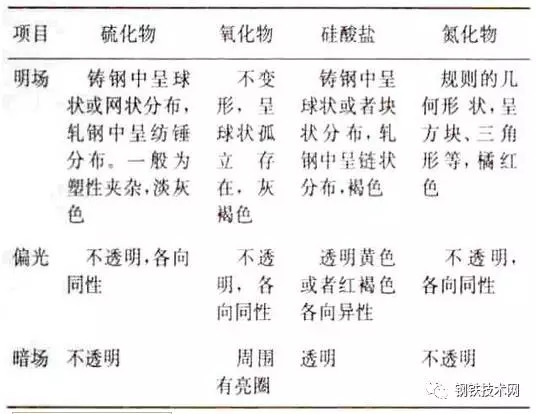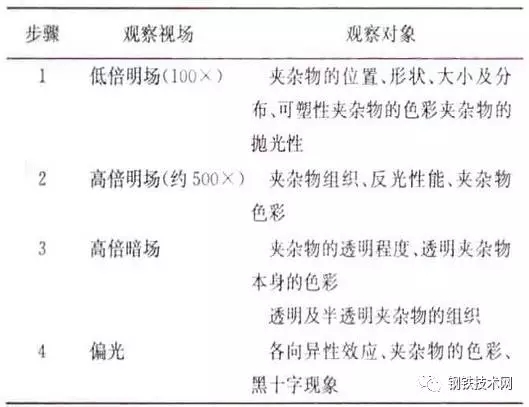With the development of modern engineering technology, the comprehensive performance requirements for steel are becoming more and more strict, and the material requirements for steel are correspondingly higher and higher. Non-metallic inclusions exist as independent phases in the steel, which destroys the continuity of the steel matrix, increases the heterogeneity of the microstructure in the steel, and seriously affects the various properties of the steel. For example, non-metallic inclusions cause stress concentration and cause fatigue fracture; inclusions with a large number and uneven distribution can significantly reduce the plasticity, toughness, weldability and corrosion resistance of steel; sulfides in the form of a network in steel can cause Hot brittleness. Therefore, the quantity and distribution of inclusions has been identified as an important indicator for assessing the quality of steel and is listed as a routine inspection item for high quality steel and high quality steel.
The properties, morphology, distribution, size and content of non-metallic inclusions have different effects on steel properties. Therefore, improving the quality of metal materials, producing clean steel, or controlling the properties and requirements of non-metallic inclusions is an arduous task in the process of smelting and ingot casting. For metallographic analysts, how to correctly judge and identify non-metallic inclusions becomes very important.
Sources of non-metallic inclusions in steel 1 classification. Endogenous inclusion
During the smelting process of steel, the deoxidation reaction produces products such as oxides and silicates. If the molten steel does not float before solidification, it will remain in the steel. The impurity elements such as oxygen, sulfur and nitrogen dissolved in the molten steel are precipitated from the liquid phase or solid solution in combination with other elements during the cooling and solidification due to the decrease in solubility, and finally remain in the steel ingot, which is the metal in the steel ingot. Inclusions formed by various physical chemical melons during the smelting process. The distribution of endogenous inclusions is relatively uniform and the particles are small. Correct operation and reasonable technological measures can reduce the number and change its composition, size and distribution, but it is generally unavoidable.
2. Foreign inclusions
Steel slag suspended in the surface of molten steel during smelting and casting, or refractory materials or other inclusions falling from the inner wall of steelmaking furnace, tapping tank and ladle are not removed in time before solidification of molten steel and remain in steel. . It is an inclusion produced by the contact of metals with foreign materials during the smelting process. For example, sand and lining on the surface of the charge react with the molten metal to form slag and remain in the metal, which also includes the added flux. This kind of inclusions are generally irregular in shape, large in size, and have no regularity. They are also called coarse inclusions. This type of inclusion can be avoided by proper operation.
Non-metallic inclusions in steel are classified by chemical composition . The non-metallic inclusions in steel are classified according to the chemical composition in detail as shown in Figure 1. They are mainly divided into three categories.
Fig.1 Classification of non-metallic clips in steel according to chemical composition1 . Oxide inclusion
Simple oxides include FeO, Fe2O3, MnO, SiO2, Al2O3, MgO and Cu2O. In cast steel, inclusions are more common when deoxidizing with ferrosilicon or aluminum. In steel, it is often distributed in a spherical shape in a spherical form. Complex oxides, including spinel inclusions and various calcium aluminates, as well as calcium aluminates (Figure 2b). Silicate inclusions are also complex oxide inclusions. Such inclusions include inclusions such as 2FeOSiO2 (iron silicate), 2MnO.SiO2 (manganese silicate), and CaO.SiO2 (calcium silicon salt) (Fig. 3a). During the solidification process of steel, some liquid silicates are not as crystalline due to the rapid cooling rate, and all or part of them are stored in steel in the form of glass too.
2. Sulfide inclusion
Mainly FeS, MnS and CaS. Since low melting point FeS is easy to form hot brittle, it is generally required that the steel contain a certain amount of manganese, so that sulfur and manganese form a higher melting point of MnS and eliminate the harm of FeS. Therefore, the sulfide inclusions in steel are mainly MnS (Fig. 3b).
The form of sulfide inclusions in as-cast steel is generally divided into three categories: 1 is spherical, and such inclusions usually appear in steels that are deoxidized by ferrosilicon; 2 observed under the optical microscope as a chain-like fine Needle-like inclusions; 3 in a block shape, irregular shape, appearing when excess aluminum is deoxidized.
Figure 2 Alumina and calcium aluminate inclusions under scanning electron microscopy
Figure 3 silicate and manganese sulfide inclusions under scanning electron microscopy3. Nitride inclusion
When an element having a higher affinity for nitrogen is added to the steel, nitrides such as A1N, TiN, ZrN and VN are formed. During the tapping and casting process, the molten steel is in contact with air, and the amount of nitride is significantly increased.
Classification by plastic deformation ability of inclusions
       1 . The shape and size of the inclusions do not change during the thermal processing of brittle inclusions, but may be arranged in a string or in a chain shape along the processing direction. Al2O3 and Cr2O3 are among the inclusions.
    2. When the plastic inclusions are thermally deformed, the inclusions have good generality and extend in a strip shape along the deformation direction. This type of iron manganese silicate has a sulfide content and a low content (40% to 60%).
3. The spherical invariant inclusions are spherical and remain spherical after hot working, such as SiO2 and silicates with higher SiO2 (>70%).
4. Semi-plastic inclusions refer to various complex aluminosilicate inclusions. The base aluminosilicate has plasticity and will be plastically deformed during hot working, but the precipitated phase contained therein, such as alumina, is brittle, and remains as it is when it is processed or is simply pulled apart.
Identification of inclusions Early workers used optical microscopes combined with X-ray structural analysis and chemical composition analysis to accumulate valuable experience and rich data. In recent years, the use of electron probes for the analysis of inclusions in the micro-area has been increasing. There are currently two general methods for identifying inclusions.
1. Metallographic method combined with micro-regional component analysis
After selecting the unidentified inclusions in the metallographic observation, the electronic region probe (EPMA) is used for the analysis of the micro-area components or by scanning electron microscopy (SEM) with the energy spectrum analysis (EDS) for component analysis. It is usually possible to measure the constituent elements and approximate components of inclusions larger than 1 um in size, and more intuitive results can be obtained if surface scanning with individual elements is used. Figure 4 is a surface analysis of an inclusion in Q460 steel using a scanning electron microscope. Surface scanning of four elements of sulfur, manganese, silicon and iron is performed in sequence. From the scanning results, it can be inferred that the inclusions in the bright field observation For MnS, SiO2, and FeS, the composition of the components can be directly analyzed by energy dispersive spectroscopy (EDS), and the mass fraction of each element can be directly obtained.
Figure 4 Scanning electron mirror scanning of inclusions2 . Optical metallography
Under the optical microscope, the bright field is used to observe the color, shape, size and distribution of the inclusions; the intrinsic color and transparency of the inclusions are observed under the dark field; and the various optical properties of the inclusions are observed under orthogonally polarized light to determine Type of inclusion. The corresponding grades were evaluated according to the distribution and quantity of inclusions, and the influence on the properties of steel was judged. At present, there are many methods for testing and studying non-metallic inclusions in steel, such as chemical method, petrographic method, metallographic method, electron probe and electronic scanning method.
Metallographic methods for identifying inclusions are based on the morphology and distribution of inclusions and their optical characteristics in brightfield, darkfield, and polarized light (Table 1), and are compared to known inclusion characteristics to determine their type. The microhardness of the inclusions or the ability to withstand chemical attack can be determined as necessary. The metallographic method for the identification of non-metallic inclusions is shown in Table 2.Table 1 Optical characteristics of common non-metallic inclusions

Table 2 Metallographic identification of non-metallic inclusions

Quantitative rating of non-metallic inclusions 1 . National standard rating
Quantitative determination is one of the routine testing items for high quality steel and high quality steel. Under the condition that the type of inclusion is known, the standard grade comparison method is adopted to determine whether the quality of the steel is good or bad. The inclusions can be rated according to the GB/T10561-2005 standard. After the sample has been carefully polished, the inclusions should be kept intact and observed under a microscope with a magnification of 100 times without erosion. The grade of the most severe field of view on the sample is compared to a standard level picture to assess its rating. The GB/T10561-2005 standard lists the level diagrams of the three types of inclusions. Oxides are one type, and the sulfides are subdivided into two series according to the most serious coarse inclusions. Each series is divided into 5 grades. The higher the grade, the more the inclusions are. If you can't evaluate an integer when rating, you can use half level. As the alloy structural steel or tool steel used for important parts, the qualified grade of non-metallic inclusions shall be determined according to the requirements of the parts. For alloy structural steels, the highest level shall not exceed 3 grades of oxides and sulfides, and the sum of the two. It is 5.5.
Chromium rolling bearings are classified and rated according to the GB/T18524-2002 standard. Standard non-metallic inclusions are classified into three categories: brittle inclusions, plastic inclusions, and point-invariant inclusions. Each category is divided into 0.5, 1, 1.5, ..., 4 and 8 standard grades. The level of non-metallic inclusions in the bearing steel shall not exceed the requirements in Table 3.
Table 3 Permissible levels of non-metallic inclusions in bearing steel
In order to quantitatively study the influence of inclusions on the performance, it is necessary to determine the statistical distribution of the size and spacing of the inclusions, and when the inclusions are fine, it is carried out under an electron microscope. Quantitative measurements require the determination of more fields of view to obtain a statistical distribution. The application of an automatic image analyzer can greatly speed up the progress of the measurement work and obtain more accurate results.
2 . JK standard rating
The inclusions are divided into four basic types A, B, C and D, which are sulfides, alumina, silicates and spheroidal oxides, respectively. Each type of inclusion can be divided into two series of fine and coarse according to the thickness and diameter. Each inclusion consists of a five-level picture (1~5) indicating an increasing number of inclusions. When assessing the inclusion level, a half grade is allowed. The result is expressed in terms of the number of levels of the worst field of view for each type of inclusion in each sample. The method for evaluating non-metallic inclusions in steel can refer to the GB/T10561-2005 standard.
3 . ASTM rating standard
The ASTM standard rating chart is also called the modified JK chart. The classification of inclusions in the rating chart is the same as the JK rating standard chart, but the rating chart consists of 0.5~2.5, which is suitable for evaluating inclusions of high-purity steel. Commonly used in products that withstand large amounts of calendering, such as sheets, tubes and wires. The result is expressed in terms of the total number of fields of view for each class of inclusions.
Although the content of non-metallic inclusions in steel is small, it has a great influence on the performance of steel, so it must be qualitatively and quantitatively tested. According to the different optical characteristics of the inclusions under the microscope, the non-metallic inclusions in the steel can be qualitatively identified. The classification of the inclusions can be quantitatively evaluated by combining relevant standards and related micro-area composition analysis, and the quality of the steel can be determined comprehensively to find out the law. Improve the process to minimize the content of harmful inclusions and improve product quality.
Laser Cutting Decorative Panel
Laser Cutting Decorative Panel
|
Product Type
|
Room Divider,Partition Screen, Laser Cut Screen,Sliding/ Folding Screen ,Wall Panel Screen
|
|||
|
Finish
|
Powder coated/ wood color
|
|||
|
Fabricating Method
|
Laser cutting hollow-out, Cutting, Welding, Hand Polishing
|
|||
|
Pattern
|
Customized Design available
|
|||
|
Application
|
Decorative Living Room, Hotel, Bar, etc. Indoor and outdoor public space backdrop Elevator cabin, handrail,living room, background
wall, ceiling, Kitchen equipment Specially for bar,club,hotel,bath center,villa,shopping mall. |
|||
(1)Easy to install
(3)Good whiteness,transparency, refractivity and hardness
(4)No pollution or radiation to the environment
(5)Standard: High-quality;
Laser Cutting Decorative Panel,Decorative Steel Privacy Panel,Metal Laser Cut Panels For Cladding,Metal Laser Cut Panels For Garden
HEBEI KAYI BUILDING MATERIAL TECHNOLOGY CO.,LTD , https://www.kayimesh.com